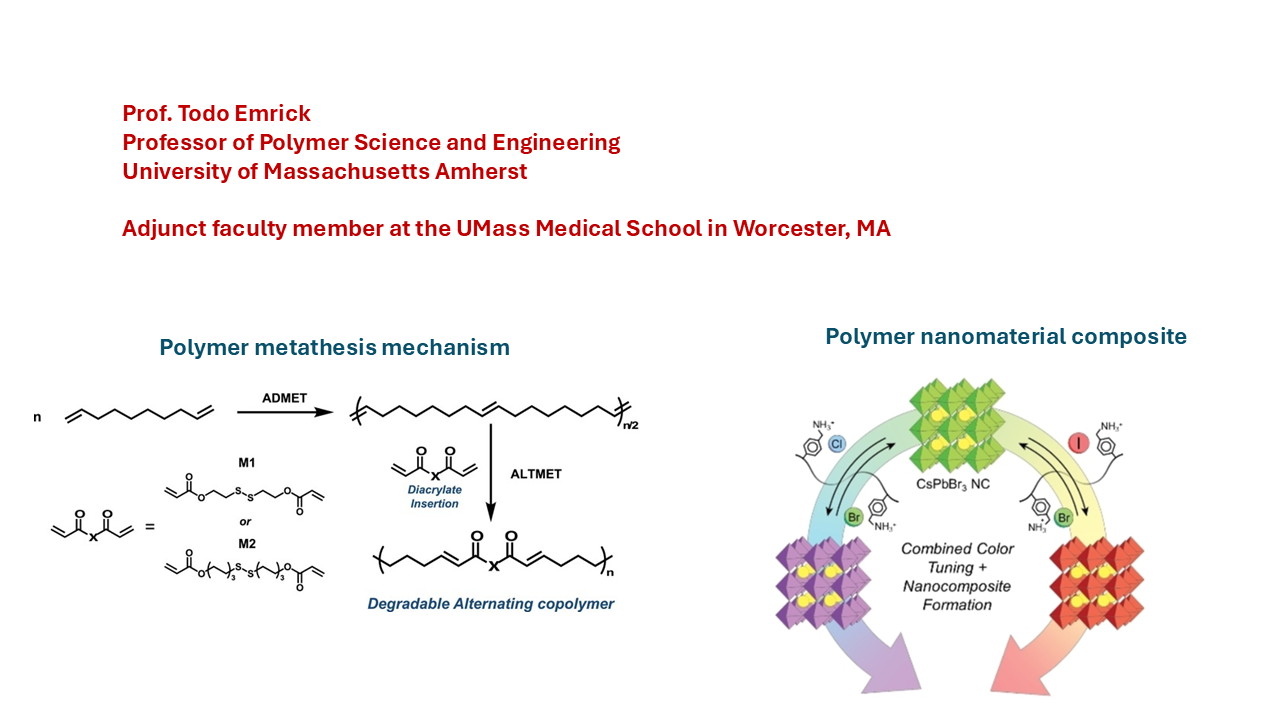3er seminario del XVI Ciclo de Seminarios del Departamento de Sistemas Físicos, Químicos y Naturales
Bio-inspired Materials Synthesis: from Optoelectronic Nanocomposites to Degradable Polymers
Información del evento
- Lugar:
- Edificio 24, Aula B06
- Inicio:
- |
- Finalización:
- |
- Ponente:
Todd Emrick
Tenemos el placer de invitaros al 3er seminario del XVI Ciclo de Seminarios del Departamento de Sistemas Físicos, Químicos y Naturales que lleva por título Bio-inspired Materials Synthesis: from Optoelectronic Nanocomposites to Degradable Polymers y que será impartido por Todd Emrick, Professor, UMass Amherst Polymer Science and Engineering Department, Adjunct faculty member, UMass Medical School, Worcester MA.
. El seminario se celebrará a las 11:00 horas del lunes, 7 de abril de 2025, presencialmente en el aula B06 del Edificio 24.
Bio-inspired Materials Synthesis: from Optoelectronic Nanocomposites to Degradable Polymers
Abstract: This lecture will describe the application of concepts and methods of organic and polymer chemistry to targets in materials science, with the objective of producing new and useful polymeric and nanocomposite structures for fundamental studies and technologies. The presentation will focus on recent work pertaining to two specific topics: 1) nanocomposite structures comprised of perovskite nanoparticles and ligating polymers and 2) polyolefin syntheses that effectively integrate key features of proteins, especially disulfide sub-units, into the polymer structure.1-4 With respect to perovskite-polymer nanocomposites, the beneficial impacts of soft-hard (polymer-nanocrystal) interfaces are realized when using polymer zwitterions to enhance nanocrystal stability and tailor photoluminescence emission intensity towards improved prospects in state-of-the-art light emitting devices. For polyolefins, the ability to insert degradable bonds into these structures holds promise towards both recycling and upcycling methodology, with disulfides offering a particularly useful route to redox-reversible synthetic methods.
Biographical information: Todd Emrick is a Professor of Polymer Science and Engineering at the University of Massachusetts Amherst and is an adjunct faculty member at the UMass Medical School in Worcester, MA. He earned a B.S. in Chemistry from Juniata College in Huntingdon, Pennsylvania (1992) and Ph.D. in Organic Chemistry with Professor Philip E. Eaton at the University of Chicago (1997). Following postdoctoral work in polymer synthesis at U California Berkeley with Professor Jean Fréchet, he began his independent position at UMass Amherst in 2001. While at UMass, his research has focused on the intersection of organic and polymer synthesis, with outlets in materials science and engineering. Advances from Emrick’s group have been recognized by the Carl S. Marvel Award for creative polymer chemistry (ACS Polymer Division), election to the National Academy of Inventors, selection as the UMass Amherst College of Natural Sciences Outstanding Researcher and the UMass Conti Fellow for Outstanding University Researchers. He is the prior Director of the NSF-supported Materials Research Science and Engineering Center (MRSEC) on Polymers at UMass Amherst (2008-2017) and is an investigator in research programs that have been supported by the National Science Foundation, Department of Energy, National institutes of Health, and Mitsubishi Chemical.
References:
1. Cueto, C.; Hu, M.Q.; Russell, T.P.; Emrick, T. Conjugated Zwitterionic Oligomers as Ligands on Perovskite Nanocrystals: Hybrid Structures with Tunable Interparticle Spacing. Journal of the American Chemical Society, 2024, 146, 12, 8189-8197. DOI: 10.1021/jacs.3c12723.
2. Cueto, C.; Hu, W.G; Ribber, A.; Bolduc, K.; Emrick, T. Polystyrene-based Macromolecular Ammonium Halides for Tuning Color and Exchange Kinetics of Perovskite Nanocrystals. Angewandte Chemie-International Edition 2022, 61(37), Article: e202207126. DOI: 10.1002/anie.202207126.
3. Seong, H.G.; Russell, T.P.; Emrick, T. Degradable polyolefins prepared by integration of disulfides into metathesis polymerizations with 3,6-dihydro-1,2-dithiine. Chemical Science, 2024, 15(41), 17084-17091. DOI: 10.1039/d4sc04468a.
4. Lee, K.; Russell, T.P.; Emrick, T. Impacts of Disulfide-Containing Monomers in Alternating Diene Metathesis Polymerization. Journal of Polymer Science, 2024, DOI: 10.1002/pol.20240838.
5. Chang, C. C.; Emrick, T. Functional Polyolefins Containing Disulfide and Phosphoester Groups: Synthesis and Orthogonal Degradation. Macromolecules 2014, 47 (4), 1344-1350. DOI: 10.1021/ma500121a

